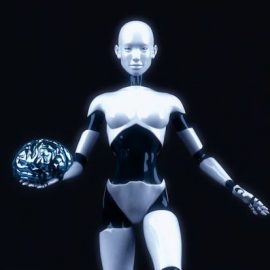
This is a free excerpt from one of Shortform’s Articles. We give you all the important information you need to know about current events and more.
Don't miss out on the whole story. Sign up for a free trial here .
What is Neuralink technology? What can this technology do? What are brain-computer interfaces?
Neuralink is a medical research company working to develop a safe, effective, and affordable brain-computer interface (BCI). BCIs allow people to control devices such as computers and smartphones with their thoughts, but in theory such devices have extensive applications and possibilities.
Read on to learn about Neuralink technology, what it can do, and what the future holds for the company.
What Is Neuralink?
Neuralink Corporation is a company that researches and designs brain-computer interfaces (BCIs). As the name suggests, BCIs are devices that (in theory) allow users to control devices like phones and computers with their thoughts. Neuralink was founded in 2016 by billionaire entrepreneur Elon Musk, alongside a small team of scientists and engineers. According to the company’s Linkedin page, it now employs around 400 people. In this article, we’ll provide an overview of what Neuralink technology is in terms of how it works, its applications and implications, and the company’s future endeavors and shortcomings.
How Does It Work?
Neuralink’s BCI consists of a device called the Link, which is invisibly implanted in the user’s skull, and numerous hair-thin wires connecting the Link to various areas of that person’s brain. The wires, called neural threads, are covered in electrodes that detect brain activity and carry signals back to the Link.
The basic concept isn’t new—a monkey was able to move a mouse cursor using a similar implant back in 2002. However, the BCIs that Neuralink is working on require much more advanced technology and surgical techniques. To give just one example, the BCI that monkey used only connected to about 30 neurons; Neuralink’s website says that their device will connect to thousands of neurons to allow users full control over their phones and computers.
Applications and Implications
Neuralink’s current focus is on accessibility—allowing people with mobility issues to use computers more easily. However, communication between a human brain and a computer has numerous other exciting possibilities. Here are just a few examples of what Neuralink technology could do:
- Treating neurological diseases and damage. In addition to helping patients function more normally, BCIs may actually be able to help a damaged brain develop new neural pathways that work around the injured or diseased areas.
- Storing and replaying memories. In a press conference, Neuralink representatives claimed that future BCIs could enable users to save their memories like files on a computer, and then access them at will.
- On a more frivolous note, Musk also imagines a future where people can play video games inside their own heads—essentially, virtual reality without the need for bulky helmets and controllers.
Next Steps for Neuralink
Neuralink is hoping to begin human clinical trials in 2023. While waiting for approval from the Food and Drug Administration (FDA), the company is asking interested people to sign up for its patient registry to see if they qualify for the trials.
However, Neuralink is still working on improving its BCI technology in order to make them effective, reliable, and affordable. Company engineers at Neuralink are also developing new technology to implant the devices—the neural threads are too small and fragile for human surgeons to work with. The FDA says that even successful clinical trials can take several years.
Neuralink’s Shortcomings
Alongside the exciting possibilities, we must take a brief look at Neuralink’s potential shortcomings.
Neuralink is currently the target of a federal investigation following accounts of unnecessarily cruel and lethal animal testing. Reportedly, the company has killed around 1,500 animals so far.
(Shortform note: The linked Reuters article incorrectly states that Elon Musk is the CEO of Neuralink. Neuralink’s CEO is actually Jared Birchall; Musk is the company’s founder and majority shareholder, but he does not hold an executive position within it.)
Furthermore, in spite of Musk’s demands and Neuralink’s reckless pace to develop its technology, the company is actually lagging behind some of its competitors. This could explain, in part, why Neuralink is so eager to explore all the different possibilities of BCI technology: It’s unlikely to put the first BCI on the market, so instead it’s aiming to deliver the best BCI.

Want to fast-track your learning? With Shortform, you’ll gain insights you won't find anywhere else .
Here's what you’ll get when you sign up for Shortform :
- Complicated ideas explained in simple and concise ways
- Smart analysis that connects what you’re reading to other key concepts
- Writing with zero fluff because we know how important your time is






